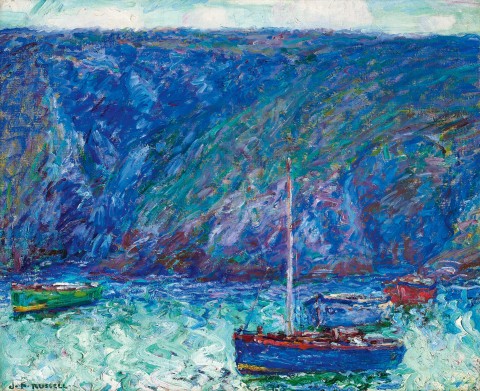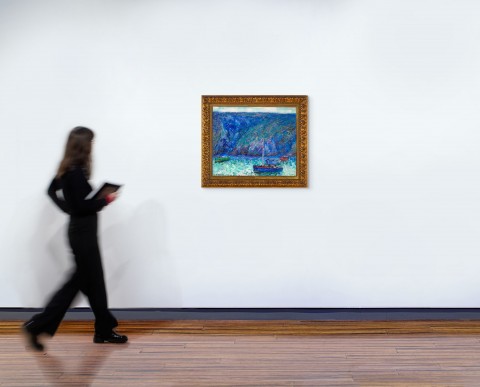CRUACH EN MAHR, MATIN, BELLE-ÎLE-EN-MER, c.1905
JOHN PETER RUSSELL
oil on canvas
60.5 x 73.5 cm
signed lower left: J. P. RUSSELL
signed verso: J. P. RUSSELL
artist’s label attached verso, signed and inscribed with title: CRUACH EN MAHR / J.P. RUSSELL / BELLE ÎLE EN MER
Private collection, France
Christie's, Melbourne, 28 April 1992, lot 186
Private collection, London, acquired from the above
Salon d'Automne, Troisième Exposition, Grand Palais, Paris, 18 October – 25 November 1905, cat. 1388 (as 'Cruach en Mahr, (matin)'), label attached to frame verso
Belle–Île: Monet, Russell & Matisse in Brittany, Art Gallery of New South Wales, Sydney, 24 November 2001 – 3 February 2002, and touring Queensland Art Gallery 14 February - 21 April 2002, cat. 30 (as 'Morning, Cruach en Mahr, Belle–Île–en–Mer (Cruach en Mahr, matin, Belle–Île–en–Mer)')
Australia's Impressionists, The National Gallery, London, 7 December 2016 – 26 March 2017 (label attached verso)
John Peter Russell: Australia's French Impressionist, Art Gallery of New South Wales, Sydney, 21 July – 11 November 2018
Galbally, A., The Art of John Peter Russell, Sun Books, Melbourne, 1977, cat. 168, p. 108
Galbally, A. et al, Belle Île: Monet, Russell & Matisse in Brittany, Art Gallery of New South Wales, Sydney, 2001, pp. 101 (illus.), 127
Riopelle, C. (ed.), Australia's Impressionists, National Gallery Company and Yale University Press, London, 2016, cat. 41, pp. 59, 107 (illus.), 118, 125
Tunnicliffe, W. (ed.), John Peter Russell: Australia's French Impressionist, Art Gallery of New South Wales, Sydney, 2018, pp. 88, 145, 146 (illus.), 152 (illus.), 228
Monet AGNSW.jpg
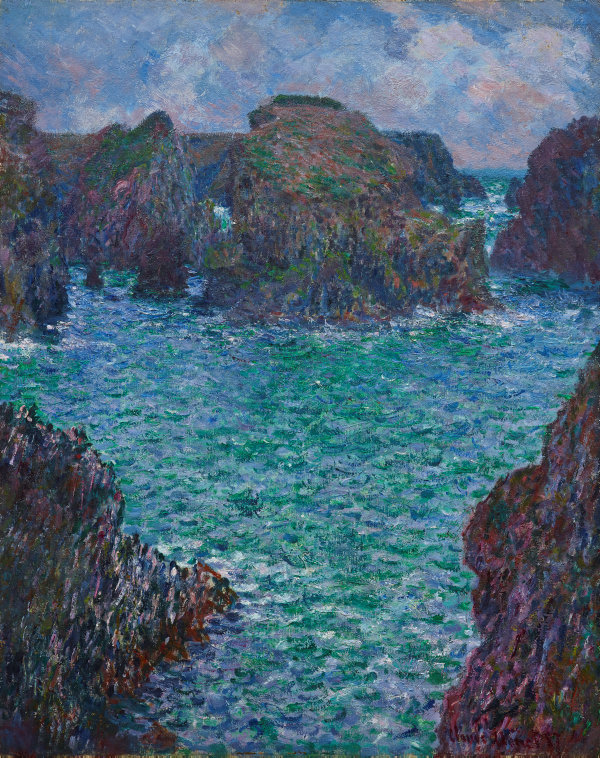
| Claude Monet Port-Goulphar, Belle-île, 1887 oil on canvas, 81.0 x 65.0 cm Art Gallery of New South Wales, Sydney |
John Russell holds a unique place in Australian art history for his close association with avant-garde circles in 1880s Paris and his firsthand acquaintance with some of the masters of European Impressionism and Post-Impressionism. Following studies at the Slade School, London in 1881, he attended Fernand Cormon’s atelier in Paris in the mid-1880s, working alongside Émile Bernard, Henri de Toulouse-Lautrec and later, Vincent van Gogh. The two artists established an enduring friendship which is documented in their extensive personal correspondence.1 Russell was one of the few artists to paint van Gogh and the 1886 portrait, now in the collection of the Van Gogh Museum in Amsterdam, was treasured by the Dutchman who later asked his brother Theo to ‘take good care of my portrait by Russell which means a lot to me.’2 There is also a sheet of profile sketches of van Gogh in the Art Gallery of New South Wales. Russell’s deep interest in Japanese art, which is reflected in the group of spring blossom paintings made during the late 1880s, was also encouraged by van Gogh who collected Japanese ukiyo-e woodblock prints – developing a collection which numbered in the hundreds – and inspiring his friend to do the same.
Vincent Van Gogh (highest res).jpg
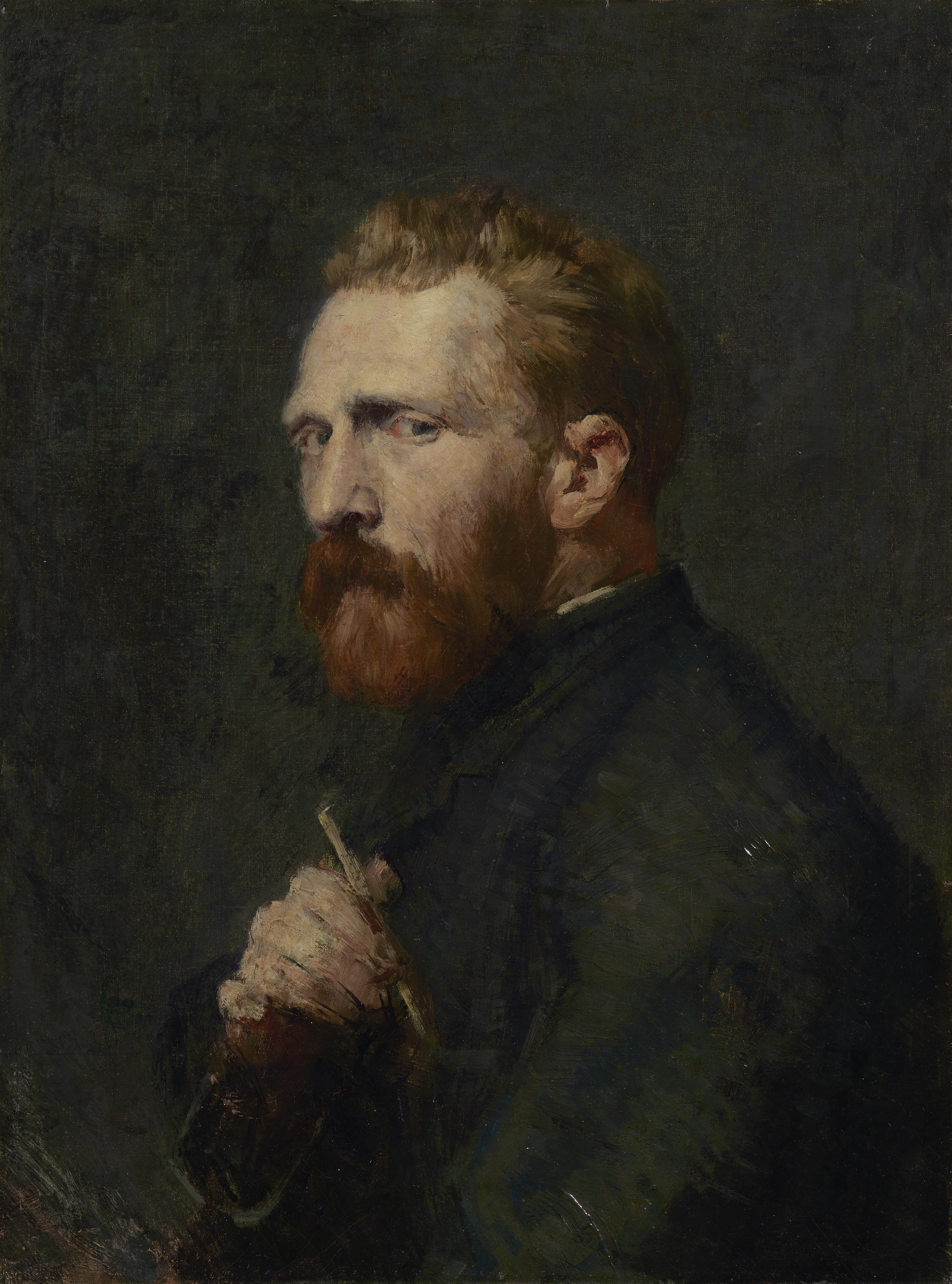
| John Peter Russell Portrait of Vincent Van Gogh, 1886 oil on canvas, 60.1 x 45.6 cm Van Gogh Museum, Amsterdam |
On a summer break from Paris in 1886, Russell spent several months on Belle-Île, one of a group of small islands off the coast of Brittany. It was here that he met and befriended Claude Monet who he saw working en plein air and, recognising his painting style, famously introduced himself by asking if he was indeed ‘the Prince of the Impressionists’. Inevitably flattered, Monet, who was eighteen years Russell’s senior, took a liking to the young Australian and dined with him and his beautiful wife-to-be, Marianna, enjoying their hospitality and company during his stay on the island. Uncharacteristically, Monet allowed Russell to watch him work and on occasion, to paint alongside him, experiences that provided the younger artist with an extraordinary insight into the techniques and working method of one of the founders of the Impressionist movement. The influence on Russell was significant and the paintings he made in Italy and Sicily only a few months later show him working in a new style, using a high-keyed palette (from which black had been banished entirely) and his compositions made up of strokes of pure colour.3 In addition to showing him how to use colour as a means of expressing a personal response to the subject, Monet’s example also highlighted for Russell the importance of working directly from nature.4
Belle-Île is part of the accurately named La Côte Sauvage, buffeted by almost constant westerly winds blowing in from the Atlantic Ocean. With a rugged landscape as yet untouched by tourism, it offered little in the way of obvious picturesque views but ‘instead… the challenge of a raw confrontation with nature for which there was no tradition of painterly representation.’5 Russell and Monet were both liberated and excited by the task of representing ‘the solid yet fantastical in the form of the rock formations on the western coastline, with the fluid and the mercurial – the sea, waves and spray … being forced beyond … previous boundaries into unknown territory.’6 During his visit to the island, Monet wrote to fellow artist Gustave Caillebotte, ‘I am in a superbly wild country, a heap of terrible rocks and an improbable sea of colours.’7 In July 1888, Russell wrote to van Gogh, ‘I am a painter of nature, of nature’s moods, of sunlight and (the) changing temper of the sea.’8 Similarly, Henri Matisse, who visited Belle-Île in 1895 and met Russell there the following year said simply, ‘Here it is wildness in all its beauty and emptiness.’9
Russell #2.jpg
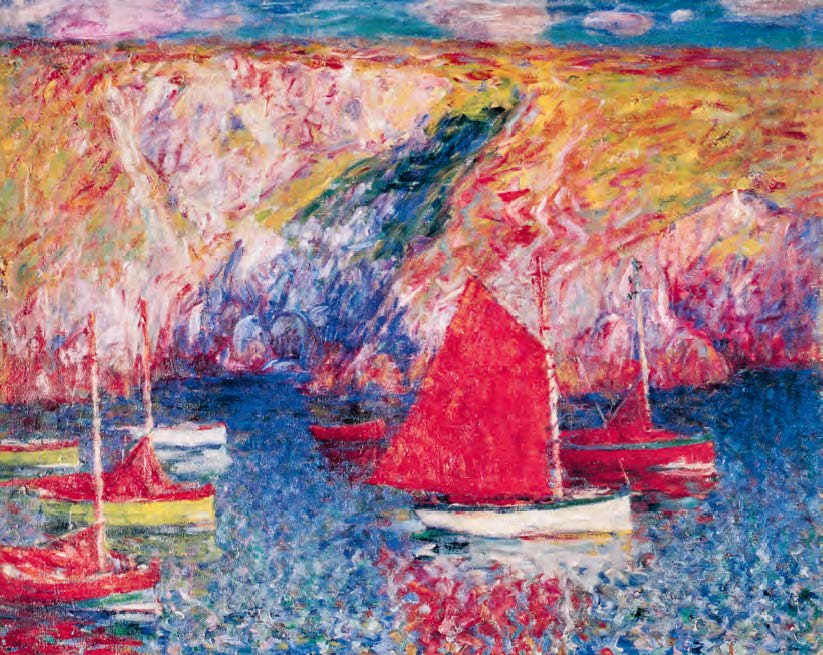
| John Peter Russell La Voile rouge, port de Goulphar, c.1900 oil on canvas, 65.0 x 80.0 cm Musée d'Orsay | Musée de Morlaix, France |
1-1637_003_AMW.jpg
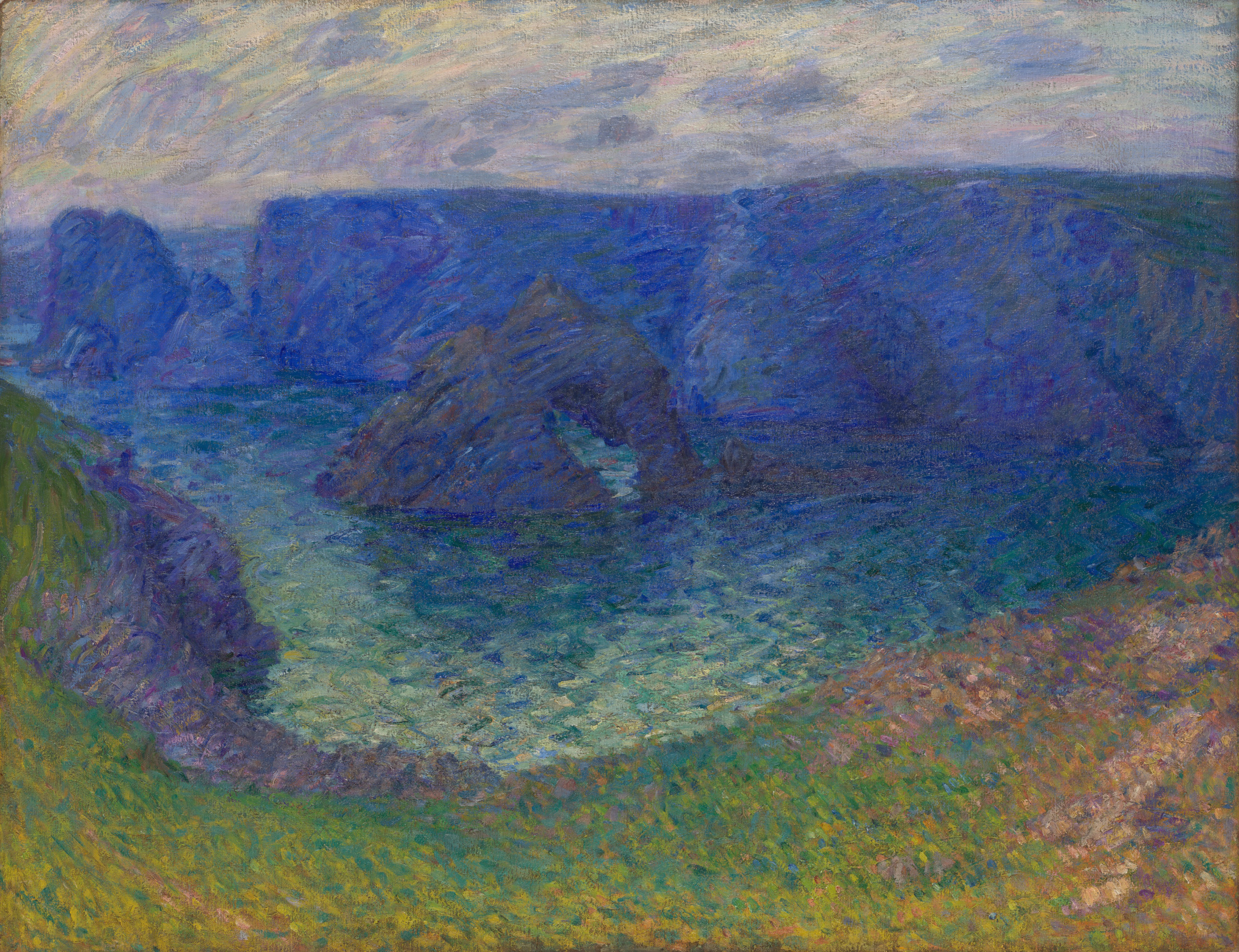
| John Peter Russell Roc Toul, Roche Guibel, 1904 – 05 oil on canvas, 98.4 x 128.0 cm Queensland Art Gallery | Gallery of Modern Art, Brisbane |
Inherited wealth afforded Russell many freedoms and inspired by the possibilities of Belle-Île, he bought land overlooking the inlet of Goulphar in 1887, writing to his friend, Tom Roberts, ‘I am about to build a house in France. Settle down for some five years. Get some work done. It will be in some out of the way corner as much as a desert as possible.’10 Building a well-appointed home known as Château de l’Anglais (or Château de Goulphar), complete with a large studio, workshop and expansive garden, Russell lived there permanently until 1909/10. He came to know the geography of Belle-Île intimately and as an accomplished yachtsman, often sailed around the island experiencing the physical power and changing moods of the ocean. While La Pointe de Morestil par mer calme (Calm Sea at Morestil Point), 1901 (Queensland Art Gallery I Gallery of Modern Art) describes tranquil waters, Rough sea, Belle-Île, 1900 (National Gallery of Victoria), captures the opposite extreme in a luminous example of Russell’s painterly dynamism, the energy of his brushstrokes mirroring the turbulence of the ocean. Russell scholar Ann Galbally has described the ‘intensity of vision’ that characterises the works made on Belle-Île, where his focus on a limited range of subjects – the sea, the rocks, rugged coastline and figure studies – encouraged bold formal experimentation in paintings that captured the changing light and atmospheric conditions of the environment, as well as displaying his committed pursuit of pure colour.11
Cruach en Mahr, Matin, Belle-Île-en-Mer, c.1905 is one of a group of paintings produced around the turn of the century that depicts the tranquil waters of Port Goulphar. Painted from a location close to Russell’s home on the south-western side of the island, it describes a view that was very familiar to him. Looking across the protected bay, it takes in a group of moored fishing boats in the foreground, the rocky coastline and undulating hillside which rises up dramatically almost to the top of the canvas, capped by a sliver of sky. The red sail, Port Goulphar, c.1900, in the collection of the Musée d’Orsay/ Musée de Morlaix, depicts a similar view, although the palette could not be more different, as vivid colours reflect the bright sunshine of mid-afternoon. By contrast (and as the title indicates), the predominantly blue, green and purple colour palette of Cruach en Mahr, Matin, Belle-Île-en-Mer – describes a morning view, before the sun has fully risen and while the hillside and water’s edge are still cast in deep shadow. Russell describes the gentle, rhythmic movement of the water in freely applied squiggles of paint and the hillside is composed of layered brushstrokes of intense colour, as well as glimpses of exposed raw canvas. Russell’s brilliance as a colourist is on full display in this painting, as is his ability to communicate as much about the feeling of being in the landscape as its physical and geographical features. Adopting the Impressionist practice of painting the same subject at different times of the day and during different seasons, Russell had an indefatigable interest in exploring the varied effects of light and weather and the resulting chromatic range of this familiar and yet ever-changing landscape. Continually inspired by Belle-Île, he wrote ‘the colours completely bowl me over. On some days here it’s ravishing but impossible for my poor palette.’12
Russell #3.jpg
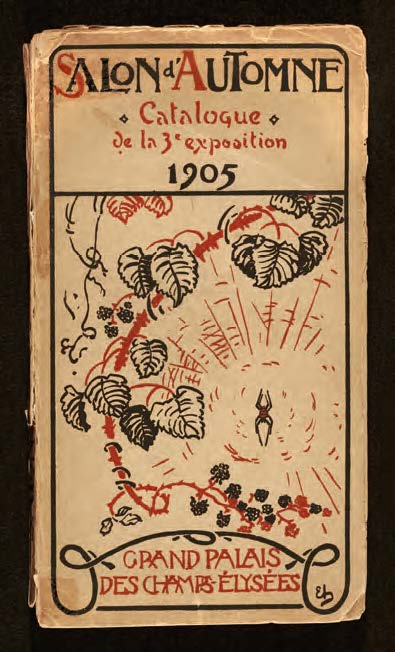
| Catalogue for the 1905 exhibition of the Salon d'Automne at the Grand Palais Des Champs Elysées, Paris, France Smithsonian Institution, Washington DC |
Russell portrait.jpg
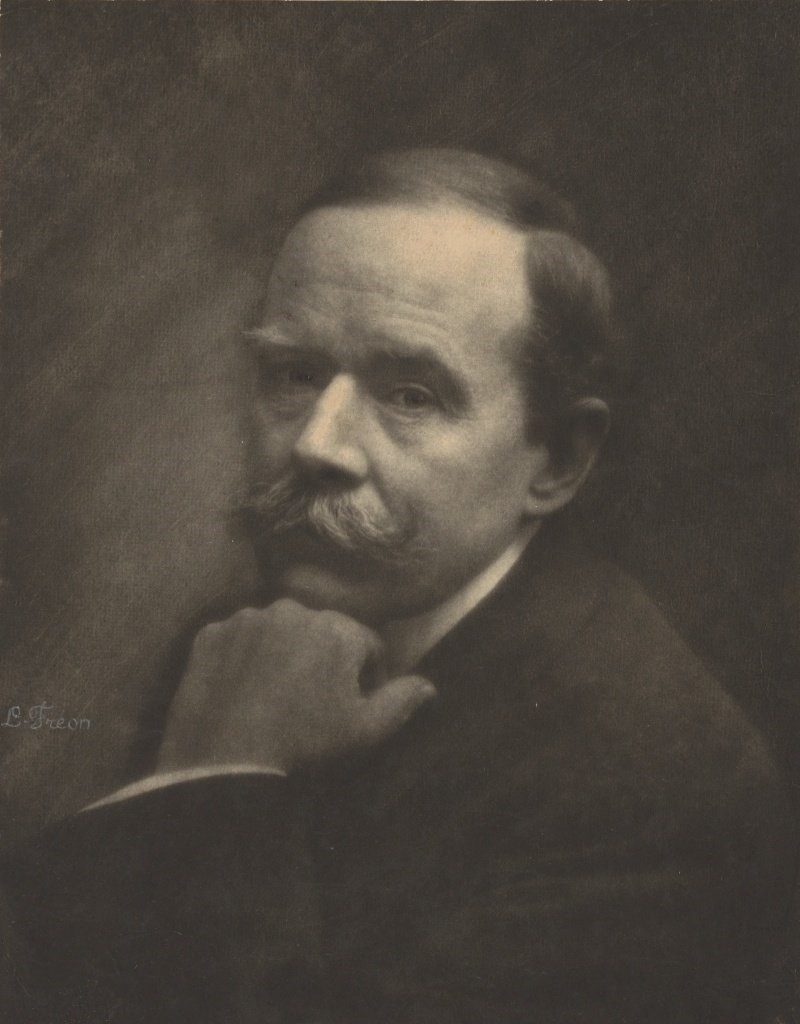
| Louis Freon Portrait of John Russell, Neuilly, Paris, c.1908 National Library of Australia, Canberra |
Russell evidently regarded this painting highly, as it is one of only a small number he chose to exhibit publicly during his lifetime. He entered it into the 1905 Salon d’Automne, the newly-established annual exhibition held at the Grand Palais in Paris, which displayed the most progressive contemporary art, and the label attached to its frame is evidence that it was accepted and catalogued as number 1388. The 1905 Salon d’Automne is particularly significant as the occasion on which the term ‘Fauvist’ was coined in response to the ‘wild dashes of colour’ in the new paintings of Henri Matisse, André Derain and Maurice de Vlaminck. It is apposite that Russell was represented in this salon given the role he had played in the dramatic transformation of Matisse’s approach to colour and indeed, given his own reputation as one of the most daring and talented colourists of his day. The young Frenchman spent three months on Belle-Île in 1896, fortuitously meeting Russell who subsequently introduced him to Monet’s techniques and to the work of van Gogh, gifting him one of the pen and ink drawings the Dutchman had sent him from Arles some years earlier. This encounter contributed to the development of what his biographer, Hilary Spurling, described as ‘a way of seeing: the first inklings of the pursuit of colour for its own sake that would draw in the end on his deepest emotional and imaginative resources.’13
In more recent years Cruach en Mahr, Matin, Belle-Île-en-Mer has been included in several important exhibitions: Belle-Île: Monet, Russell & Matisse in Brittany at the Art Gallery of New South Wales in 2001; the John Russell retrospective, Art Gallery of New South Wales, 2018 and the 2016 – 17 exhibition, Australia’s Impressionists, at the National Gallery, London. The first ever exhibition in the United Kingdom to focus on the art of Australia’s Impressionists, this show was part of the National Gallery’s expanded mission to collect, display and study the work of artists working within the tradition of European representational painting but further afield, away from the places usually acknowledged as the centres of artistic production.14
Russell #4.jpg
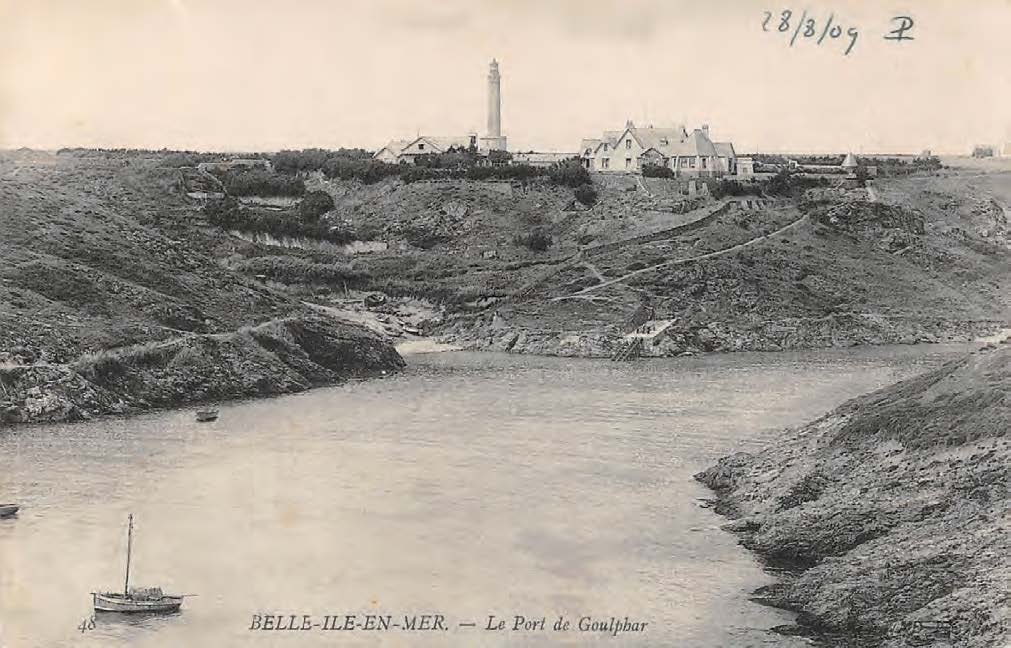
| Belle-île-en-Mer, Le Port de Goulphar with Russell's house 'Le Chateau Anglais' prominent above the cliff, c.1909 |
Elaborating on the significance of Cruach en Mahr, Matin, Belle-Île-en-Mer within Russell’s oeuvre and its importance in the exhibition, the Director of the National Gallery, Dr Gabriele Finaldi wrote, ‘This unconventional view of the coastline of Port Goulphar not yet fully illuminated by the rising sun suggests the lessons Russell absorbed from painting en plein air alongside Claude Monet, and the indefatigable interest Russell developed for capturing the varying effects of light and weather on the rugged landscape of his adopted home of Belle-Île. In its complex layering of intense, contrasting colour, veiled with the dominant key of electric blue, we see Russell in full force as a colourist, exploring the dense chromatic modulations of shadow.’15
Russell played a crucial role in the exhibition and indeed, an entire section of the display was dedicated to his art. Shown alongside Tom Roberts, Arthur Streeton and Charles Conder, Russell’s significant place among the very best of Australia’s artists working in the late nineteenth and early twentieth centuries was made clear, as was his utterly unique role as a vital and direct link between Australian art and French Impressionism and Post-Impressionism.
Alongside these national and international exhibitions of Russell’s work, institutional acquisitions have taken place as galleries and museums strive to ensure their collections represent the best of his painting. The offering of this painting represents an increasingly rare opportunity to acquire a major painting by John Russell.
1. Although Russell did not see van Gogh again after he departed for Arles in the south of France in early 1888, their friendship continued via correspondence. See Galbally, A., A Remarkable Friendship: Vincent van Gogh and John Peter Russell, The Miegunyah Press, Carlton, 2008
2. Taylor, E., ‘John Russell and friends: Roberts, Monet, van Gogh, Matisse, Rodin’, Australian Impressionists in France, National Gallery of Victoria, Melbourne, 2013, p. 56
3. ibid., p. 60
4. Prunster, U., ‘Painting Belle-Île’, in Prunster, U., et al., Belle-Île: Monet, Russell and Matisse, exhibition catalogue, Art Gallery of New South Wales, Sydney, 2001, p. 31
5. Galbally, A., ‘Mer Sauvage’, in Prunster, U., ibid., p. 14
6. Galbally, 2001, op. cit., p. 13
7. Prunster, ‘Painting Belle-Île’, op. cit., p. 19
8. ibid., p. 29
9. ibid.
10. Russell to Tom Roberts, 5 October 1887, cited in Tunnicliffe, W., (ed.), John Russell: Australia’s French Impressionist, Art Gallery of New South Wales, Sydney, 2018, p. 193
11. Galbally, 2001, op cit., p. 15
12. Russell to Auguste Rodin, April-May 1890, cited in Prunster, ‘Painting Belle-Île’, op. cit., p. 46
13. Spurling, H., The Unknown Matisse: A Life of Henri Matisse, Volume One: 1869-1908, Hamish Hamilton, London, 1998, p. 144, cited in Taylor, op. cit., p. 65
14. See Riopelle, C., ‘Australia’s Impressionists in a World Context’ in Australia’s Impressionists, National Gallery Company, London, 2016, pp. 14 – 16
15. Dr Gabriel Finaldi to the vendor, 16 June 2016
KIRSTY GRANT
